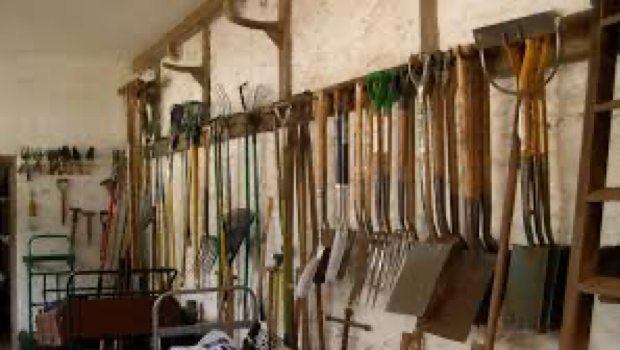Roseland Online Gardening Column, Dec 2020
As we head into winter proper, the amount of true gardening we can do lessens, but there are always other jobs to occupy us. Our tools have been well used over the year, and could now do with some fettling – strip down, sharpen and oil your secateurs, loppers and shears; clean and sharpen your spades and lawn edgers; make sure your forks and rakes are rust and dirt free; get your lawn mower and strimmer serviced ready for next year. These might seem like irksome jobs, but you will really feel the benefit when you start to use them all again. And a well-maintained tool will last you a lifetime and become an heirloom, so it is worth investing the time and effort.
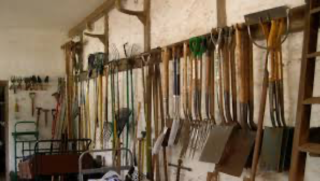
One gardening task that should be done over the winter months though (frost permitting) is to prune certain fruit trees and bushes. Apples and pears are pruned over the winter to encourage better fruit production in the coming seasons, as are the currant family, autumn raspberries and gooseberries. Don’t do the stone fruits (cherries, plums, gages etc) in the winter – they need to be pruned straight after fruiting in mid to late summer.
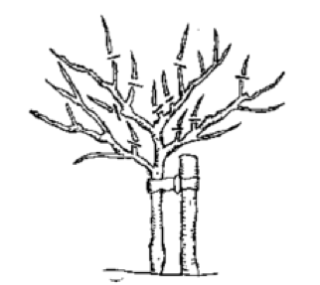
A picture is worth 1,000 words, as the old adage goes, and this picture should give you an idea of how to prune a mature pear or apple tree. The idea is to leave a predominance of short fruiting spurs, rather than the spindly leaf producing twigs. This concentrates the tree’s efforts into fruit production rather than into woody growth. And, of course, always remove the 3Ds – dead, diseased and damaged wood, to avoid weakening the plant.
Currant and gooseberry bushes should also be pruned to remove the 3Ds, but in addition, prune out the centre to form a bowl and cut back new side shoots to 1 to 3 buds – both fruit on old wood. This allows air to pass through the bush and helps with plant hygiene, particularly if you suffer with sawfly, whose eggs overwinter at the base of the plant, and when hatched into caterpillars, can defoliate a bush overnight. They don’t like the wind, so the less comfortable they are, the more likely they are to find somewhere new to live.
Autumn raspberries, very simple: just cut down to the ground and new canes will shoot from nearby next year.
Winter is also a good time of year to think about the critters that share our gardens with us, and without which our gardens would be diminished places.
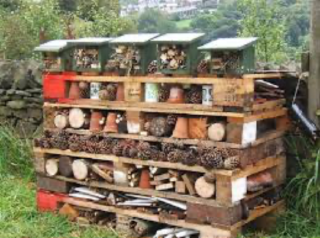 A bug hotel is a wonderfully easy thing to make this time of year – one for the kids to join in on. Old stumps of bamboo, clumps of straw, twigs, piles of stones, pipes, an old tree trunk and fallen branches can be combined loosely, or in a more rigid structure to provide shelter for all sorts of furry and creepy crawly life. Much as we may not want to meet some of these creatures face to face, they form a very important part of the ecology of our gardens, and their absence will definitely unbalance the natural order of things.
A bug hotel is a wonderfully easy thing to make this time of year – one for the kids to join in on. Old stumps of bamboo, clumps of straw, twigs, piles of stones, pipes, an old tree trunk and fallen branches can be combined loosely, or in a more rigid structure to provide shelter for all sorts of furry and creepy crawly life. Much as we may not want to meet some of these creatures face to face, they form a very important part of the ecology of our gardens, and their absence will definitely unbalance the natural order of things.
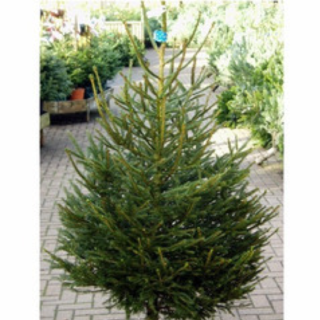 And finally, and even though Christmas this year may look quite different for some of us, it would be remiss of to write a column for December without mentioning Christmas trees. And here are a few tips about buying and caring for your tree so you get maximum pleasure from it.
And finally, and even though Christmas this year may look quite different for some of us, it would be remiss of to write a column for December without mentioning Christmas trees. And here are a few tips about buying and caring for your tree so you get maximum pleasure from it.
The first tip is, think about it early in December, even if you don’t want to put up your tree until much nearer the day. There are many disappointed people who miss out on the size and style of tree they want, because they leave it too late.
Interestingly, it is the smaller potted trees which sell first. There is no harm in buying these early, keeping them outside in a sheltered place, watering each week and bringing them in when you are ready to decorate them. If you plan to plant your tree in the garden afterwards, ask your vendor if the trees are pot-grown, or lifted and potted. Pot-grown trees have a much greater chance of establishing when planted, because their root ball will have been undisturbed through the growing process. The lifted and potted trees may have had their roots damaged as part of the lifting process, and are much less likely to establish well as a result. There are some funky little pot-grown trees available this year, such as Frasier firs, which should come with cones and smell gorgeous.
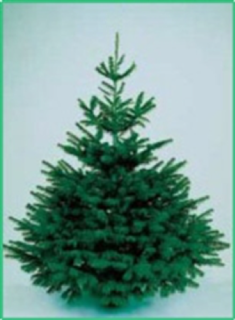 If you prefer a cut tree, there are essentially two types available – traditional Norway Spruce, or non-drop Nordmann Fir. There are 2 major differences between them – appearance and needle drop potential. The traditional Norway Spruce is the classic Christmas card tree – mid green, softer-looking, with a gentler lilt to the branches and a classic pine scent. It is quite likely to lose some needles over whole period, but if kept hydrated and in not too warm a spot, this shouldn’t be significant.
If you prefer a cut tree, there are essentially two types available – traditional Norway Spruce, or non-drop Nordmann Fir. There are 2 major differences between them – appearance and needle drop potential. The traditional Norway Spruce is the classic Christmas card tree – mid green, softer-looking, with a gentler lilt to the branches and a classic pine scent. It is quite likely to lose some needles over whole period, but if kept hydrated and in not too warm a spot, this shouldn’t be significant.
The Nordmann (non-drop) Fir has a bluer tinge to its foliage, a stiffer appearance, with more upwards pointing branches. As its name suggests, it shouldn’t lose needles, but it is also a bit more expensive per foot.
Again, there is no barrier to you buying cut trees early – simply re-cut the trunk and keep the tree in a sheltered place in a bucket of water until you are ready to bring it indoors and it will be fine. Some people swear by adding a sugary substance to the water, but quite honestly, the tree has already taken up all the nutrients it needs to survive the Christmas period; water is the only necessity.
In terms of which type of cut tree to choose, it is a very personal matter but do choose the very tree you would like – get it out of its wrapper, spin it around and check it over.
 And a plea – this year, please remember all the businesses on the Roseland that have kept you going during this weird year and buy as locally as possible. There are many suppliers of quality Christmas trees right here on the Roseland and a new Facebook group to encourage you to support Cornish crafts folk, bakers, food suppliers, wreath makers, artists, photographers – you name it, it will be represented there. Such a fabulous group. Please take a look if you use Facebook. You will be astounded by the range and quality of offerings right under our noses and not a hint of Amazon or eBay involved.
And a plea – this year, please remember all the businesses on the Roseland that have kept you going during this weird year and buy as locally as possible. There are many suppliers of quality Christmas trees right here on the Roseland and a new Facebook group to encourage you to support Cornish crafts folk, bakers, food suppliers, wreath makers, artists, photographers – you name it, it will be represented there. Such a fabulous group. Please take a look if you use Facebook. You will be astounded by the range and quality of offerings right under our noses and not a hint of Amazon or eBay involved.
On that note, it just remains for us at the Calendra Collective to wish you a very Happy Christmas and a healthy and prosperous New Year, however it will look for you. Be sensible, stay safe, stay local and keep well.
Helen Robins, Calendra Collective
Calendracollective@outlook.com

